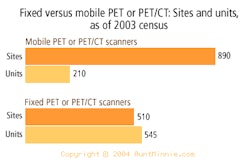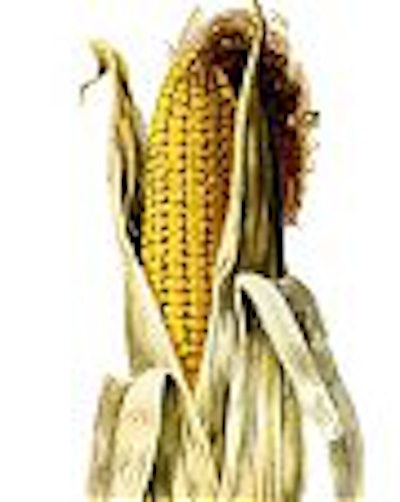
A tall glass of citrus-and-vanilla-flavored corn oil may not whet your whistle, but it is an effective, inexpensive, and palatable gallbladder stimulant for the scintigraphic diagnosis of chronic acalculous cholecystitis (CAC), according to nuclear medicine specialists from -- where else? -- Iowa, a state that grew more than 2.2 billion bushels of corn in 2004.
The group from the University of Iowa Hospitals and Clinics in Iowa City tested a corn oil emulsion as a potential alternative to sincalide, a cholecystokinin that is a commonly used gallbladder stimulant analog (Kinevac, Bracco Diagnostics, Princeton, NJ).
"Even with the current availability of sincalide in the United States, corn oil emulsion may still be preferable in that it is more physiologic, free of side effects, easier to administer, and considerably less expensive," wrote Dr. Twyla Bartel and colleagues in the Journal of Nuclear Medicine. "In this study, we have used a corn oil emulsion preparation based on a specific formula as an alternative to sincalide. Our experience with this standardized fatty meal has been encouraging," (JNM, January 2005, Vol. 46:1, pp. 67-74).
The study looked at 30 patients who had been referred for recurrent postprandial abdominal or right upper quadrant pain. There was no evidence of cholelithiasis on their ultrasound exams. The corn oil emulsion was made at the institution's pharmacy, based on a formula for a discontinued product called Lipomul. It consisted of 10 g/15 mL of corn oil, 6.3 mg/15 mL of saccharin sodium, and artificial citrus vanilla flavoring. The total caloric content was approximately 170 calories per 30 mL patient dose. The patients underwent dynamic hepatobiliary imaging using a large field-of-view γ-camera after intravenous injection of 185 MBq of 99mTc-disofenin and the consumption of the corn oil emulsion.
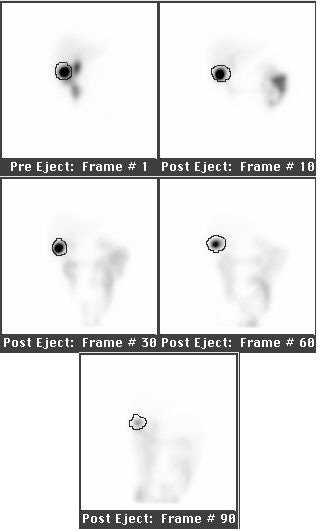 |
| A normal GBEF on scintigraphy with corn oil emulsion. All images courtesy of Dr. Malik Juweid and Dr. Twyla Bartel. |
Of the 30 patients, seven had evidence of CAC that was documented at cholecystectomy. The majority of the remaining patients (23) had other conditions -- gastritis, hiatal hernia, pregnancy -- but did not have gallbladder disease.
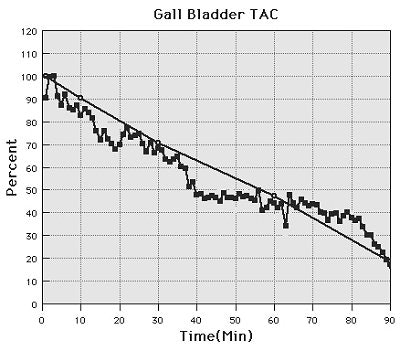 |
| A normal time-activity curve. |
The 30-minute gallbladder ejection fraction (GBEF) was 25% mean ± 22% standard deviation. The 60-minute GBEF was 47% ± 28%. The 90-minute GBEF was 62% ± 29%. In the CAC patients, the GBEFs for 30-, 60-, and 90-minute exams were 6% ± 6%, 13% ± 7%, and 29% ± 22%, respectively. In the non-CAC patients, the GBEFs for 30-, 60-, and 90-minute exams were 30% ± 22%, 57% ± 24%, and 72% ± 23%. These differences were deemed statistically significant by the authors.
"The 60-min GBEF appears to give the best separation between groups," they wrote. "A 60-min GBEF of ≤ 20% was associated with 100% sensitivity and approximately 100% specificity for the diagnosis of CAC. The positive and negative predictive values and accuracy for diagnosing CAC at this cutoff was 88%, 100%, and 97%, respectively." The 90-minute GBEF results were similar to those of the 60-minute exam, with only the 30-minute exam proving inferior, they stated.
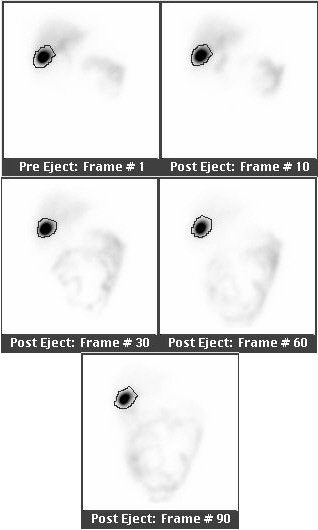 |
| An abnormal GBEF on scintigraphy with corn oil emulsion. |
One "quirk" of this technique was that the gallbladder continued to empty in some patients, even 90 minutes after ingesting the emulsion. The authors suggested this occurred because of continued gastric emptying of the fatty liquid into the duodenum, resulting in subsequent gallbladder contraction. Still, "regardless of whether maximal gallbladder emptying was reached by 60 or 90 min ... the GBEF measures (for both) provided excellent accuracy for diagnosing CAC."
The authors stated that there were no reports of side effects with the corn oil emulsion and that reproducing the mixture was easily done by the pharmacists. Also, at the time of the study, the corn oil emulsion, at $34.30 for a 100 mL bottle, was $14.42 less than a one-dose vial of sincalide.
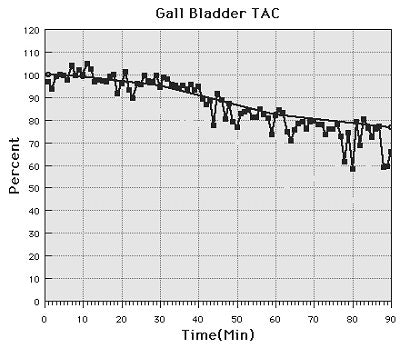 |
| An abnormal time-activity curve. |
However, the retrospective study did have certain limitations, including the lack of universal quality control for the product and the lack of a healthy control group. A head-to-ear comparison of sincalide and corn oil emulsion is necessary, they stressed.
The group plans to do a direct comparison test between the two, wrote co-author Dr. Malik Juweid in an e-mail to AuntMinnie.com. In the meantime, gallbladder studies will be performed with the established agent, sincalide, he stated.
By Shalmali Pal
AuntMinnie.com staff writer
January 20, 2005
Corn illustration courtesy of www.classroomclipart.com.
Related Reading
Hypnosis relieves distress of voiding cystourethrograms in children, January 5, 2005
Nuclear medicine specialists find success with corn-fed cholescintigraphy, October 3, 2003
Bracco set to reintroduce Kinevac, December 6, 2002
Ice cream pretreatment improves myocardial sestamibi imaging, October 18, 2002
Good to the last drop: Caffeine enhances BOLD fMRI results, May 14, 2002
Copyright © 2005 AuntMinnie.com







